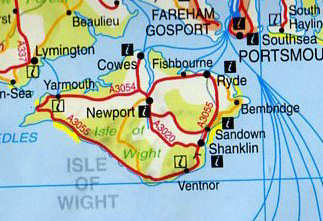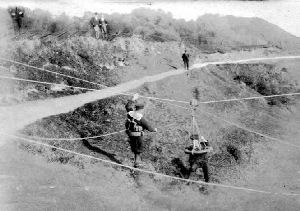INFANT FOUND IN CLOSET.
1st.January 1866.
On Sunday morning last an infant child was found in a closet belonging to the house of Mr. Wade, Coastguard, which stands on the cliff at St. Lawrence. An inquest was held at the St. Lawrence Hotel where Elizabeth Wade, the wife of George Wade, the Coastguard, said we live at Orchards Bay, St. Lawrence Bay , which is used in connection with the Preventive station, It only consists of one house and no-one occupies the house but ourselves , a girl age 14 and a boy aged 12--- (1)
Struck by Lightning.
29th August 1896. During a sharp thunderstorm that passed over the island on Wednesday, the Atherfield Coastguard Station was struck by lightening. The chimney of the Chief Boatman in charge, Mr McCarthy, was destroyed and much damage done to the masonry and woodwork. The lightening fired the telephonic communication with Mr. McCarthy's bedroom and set on fire the woodwork of the instrument. Mr. McCarthy who was at the time receiving a communication and Jesse Woolven the watchman on duty, were thrown violently through the doorway for some yards, but they fortunately escaped without serious injury. (2)

The Totland lifeboat.
The Totland lifeboat was first operated in the 1880's. Sometimes smugglers and Coastguards comprised the same crew when shipwrecked lives were at stake. This invariably happened when some of the smuggling crew members were absent on contraband runs and replacements had to be found in a hurry. Smugglers and Coastguards sat side by side in the same boat, grimfaced and never saying a word to one another, but still intent on doing their duty.
| Link Removed | | Link Removed | | Link Removed | | Link Removed | | Link Removed |

Wit & Wisdom.
"On a Play that did not Please.
"The play was a great success, but the audience was a failure"
Oscar Wilde.
On Happiness :- Happiness is no laughing matter.
Archbishop Whately (1787-1863) Apophthegms."
|
Wreck of Sailing Ship "Irex". 1st February 1890
One of the most disastrous wrecks which has occurred for many years ---- the rocket apparatus arrived from Freshwater Bay and through the excellent management of the officer in charge, Coastguard Mr. Spilman, the first rocket was fired from the inside of the fort at 1.10, it was a splendid shot fired by Coastguard Hallet----- The brilliant and skilful handling of the rocket apparatus by Mr. Spilman and his gallant corps cannot be too highly praised.-------Coastguard Machin went off and brought a lad safely to shore. (2)
Coming in February The Sinking of the "Vanguard" Warship.. | | |
|
Dear Friend, Welcome to the January edition of "The Coastguard Cutter". A New Year.
At the beginning of a New Year we would like to send Best Wishes to our Readers and to Coastguard Organisations Worldwide. A monthly magazine called "Ryde Beacon", published in the Isle of Wight, England, was sent to me recently. It contained an extremely interesting account of the shipwreck of the SS Eider on the 23rd. January 1892 at Atherfield and the saving of 379 people on board. There was also an article on "Ryde Coastguard Station" contributed by Tony Gale.
So this month we will change focus from this Island of Ireland to an Island with a strong history of smuggling and Coastguard activity- the Isle of Wight. Enjoy,
Tony.
| The Isle of Wight.  The Isle of Wight has had its own share of smuggling on the south coast of England. There were excellent open shores partially sheltered by the Isle of Wight, on which to beach a vessel, especially near Selsey and on Hayling Island. The proximity of the Isle of Wight was particularly useful after 1840 when the mainland coast was generally too well guarded. Smuggling on Wight continued into the 1860's and it was relatively easy to bring goods across in small boats from the harbour at St. Helens. The Isle of Wight has had its own share of smuggling on the south coast of England. There were excellent open shores partially sheltered by the Isle of Wight, on which to beach a vessel, especially near Selsey and on Hayling Island. The proximity of the Isle of Wight was particularly useful after 1840 when the mainland coast was generally too well guarded. Smuggling on Wight continued into the 1860's and it was relatively easy to bring goods across in small boats from the harbour at St. Helens.
| | | Isle of Wight - Capture of a smuggler and six men 1844.
The 'Stag' Revenue Cruzier, being off the Isle of Wight on the night of the 22nd.last, sent her boats along shore on the look-out. One of them being off St. Catherines, and close under the cliffs, just after midnight, saw a sail standing in from the S.E. The smugglers did not perceive the boat till they were close in upon her, when they immediately cut away their crop of tubs which, were lashed around their vessel, outside the bulwarks, when they fell into the water. The cutters boat was within 15 yards of them; the cutters men threw over their mark buoy, and flashed for the cutter; the flash was seen, and, returned; or it might have been awkward, as the smuggler had more hands than the boat. After searching the vessel, they went to their buoy and creeped for their tubs, which they soon succeeded in capturing. But the stones attached to them were so heavy they could not get them till they got the assistance of another boat from the cutter. Then they got the crop consisting of 79 casks of spirits or brandy, which with the men and vessel, they took round to Cowes. The men were taken before the magistrates at Newport, examined and committed for trial. Captain Clark is but newly appointed to the 'Stag' and has thus made for himself and crew a fortunate commencement. (3) Some members of a smuggling family living at Grange barracks used to get up in the dark and go down to the shore to see if anything had been washed up during the night. One morning they found a crop of tubs on the beach. They carried them up to Marsh Green copse to bury them completely until they could make arrangements to dispose of them. They used to get about £3 per tub. However when they returned to the copse the tubs were gone. They never saw them again, but the soldiers stationed at the barracks were drunk for weeks afterwards.
Practice 
Isle of Wight Coastguards wearing life-jackets practice use of bosun's chair.
Ryde Coastguard Station. The forerunner of the Coastguard Service was the Preventive Water Guard that was started in 1809 during the Napoleonic Wars and was equipped with small vessels that had authority to land officers on the shore to patrol and capture smugglers and their “Free Goods” – usually tobacco, spirits and tea. The aim of the PWG was to back up the Riding Officers, 4 of whom patrolled the Island coastline. Ryde was certainly one of the Island bases for the PWG and its boats. In 1822 the PWG, Riding Officers and Revenue Cruisers that patrolled out in the Channel combined to form the Coast Guard under the control of the Board of Customs.
Many inhabitants earned or supplemented their wages by carrying bladders containing spirits concealed by their clothing to be sold in Portsmouth – it was estimated each trip could earn twelve shillings for the carrier – a great deal of money at the time.
The Station had been built by 1836 The Station had a compliment of up to 10 Coastguards and in the early years was commanded by Royal Naval Lieutenant who lived in Nelson Street. Wings Cottage still displays its link with the Coastguard Service as the “pigeon hole” cabinet for storing signal flags is still in position on the wall.
The Coastguards were closely involved with the operation of the Lifeboat and one of their number Frank Haynes was drowned in the 1907 Ryde Lifeboat Disaster.
There were many regattas held around the Island during the summer months; one was the Ryde Pier Regatta where there was a special race for Coastguard crews. In 1906 the race was won by the Stokes Bay crew with Fishbourne second and East Cowes third. A postcard of the scene shows the new boathouse, the crews lined up for the start of the race and watching crowds on the Pier. There were similar races at other Island Regattas.
Perhaps the most famous of the Ryde Coastguards was the Chief Officer appointed in 1873, William Thomas Rickard, who had won the Victoria Cross for personal bravery in rescuing a shipmate whilst under fire, during the Crimean War. The 1881 Census showed he lived in Nelson Street and following his retirement from the Service he became the boatman at the Rowing Club. When he died in February 1905 he had a mini state funeral with a naval escort, the Volunteers Band and the Island Coastguards as pall bearers. He was buried at Ryde Cemetery.
see William Rickard. V.C. Coastguard on Coastguard of Yesteryear site at Bravery Awards No.6.
The Ryde Station was closed down by the then Chief Officer Harry Black on the 25th August 1921.
Research and new books. Of interest to researchers. You can find a large list of Coastguards who served in the Isle of Wight at :- A brand new book which deals with the History of the Islands Coastguard stations has just come fresh off the press. This fascinating and beautifully produced book with many illustrations of Coastguards and their stations was written by Tony Gale and is called "Coastguards of the Isle of Wight". The book can be ordered from the publisher on his website www.coachhouseonline.co.uk however if sought over the telephone 01983-755655 no postage will be charged. An impressive site containing many details of Coastguards and their families has been brought to my attention by Trish Jensen of Australia. It is called British Coastguards 1841 to 1901 and features many extracts taken from Census Records in England.
www.genuki.org.uk:8080/big/Coastguards/ |
|
|

 Posted by Tony
on June 17 2007
Posted by Tony
on June 17 2007

 Posted by Tony
on June 17 2007
Posted by Tony
on June 17 2007